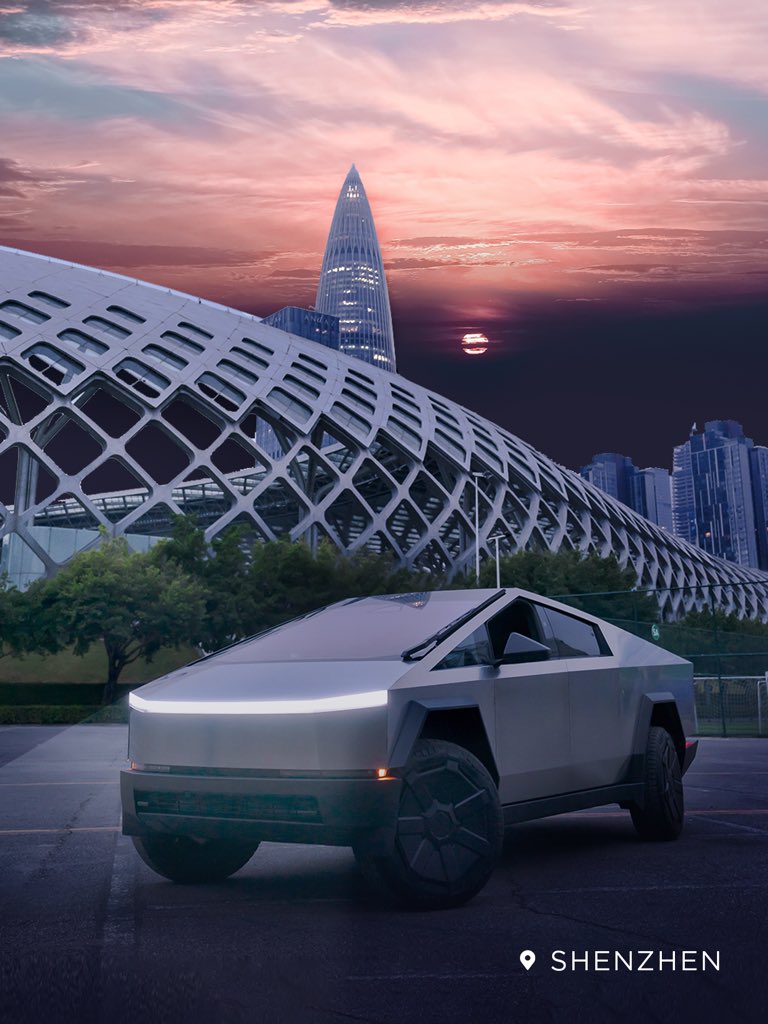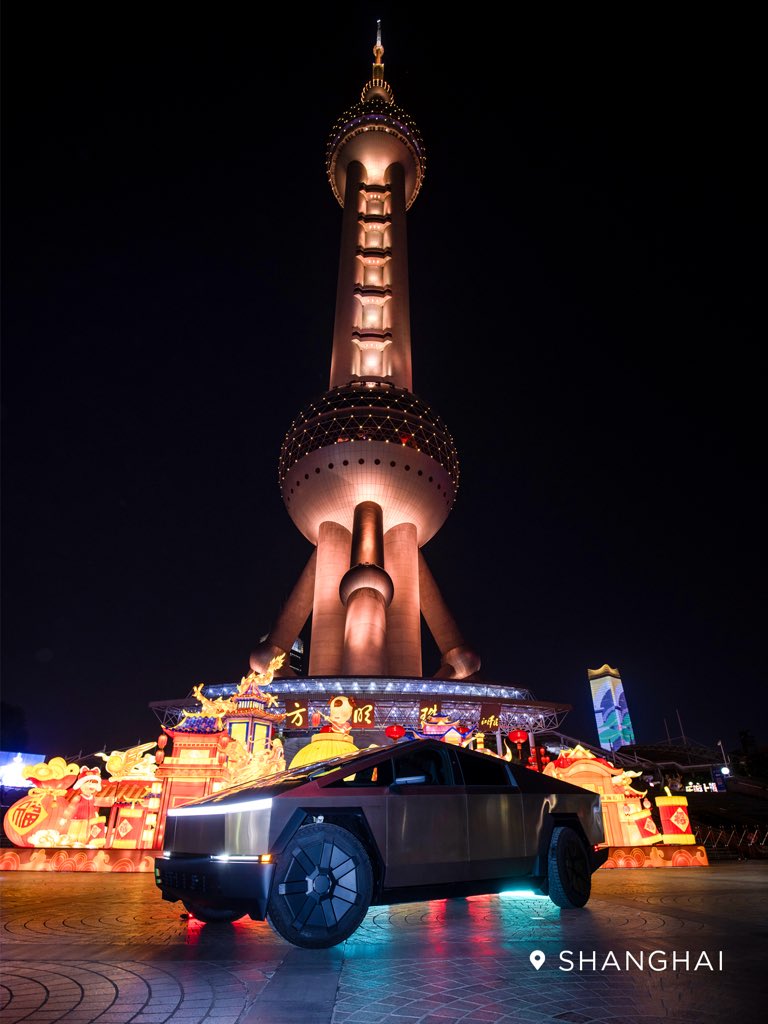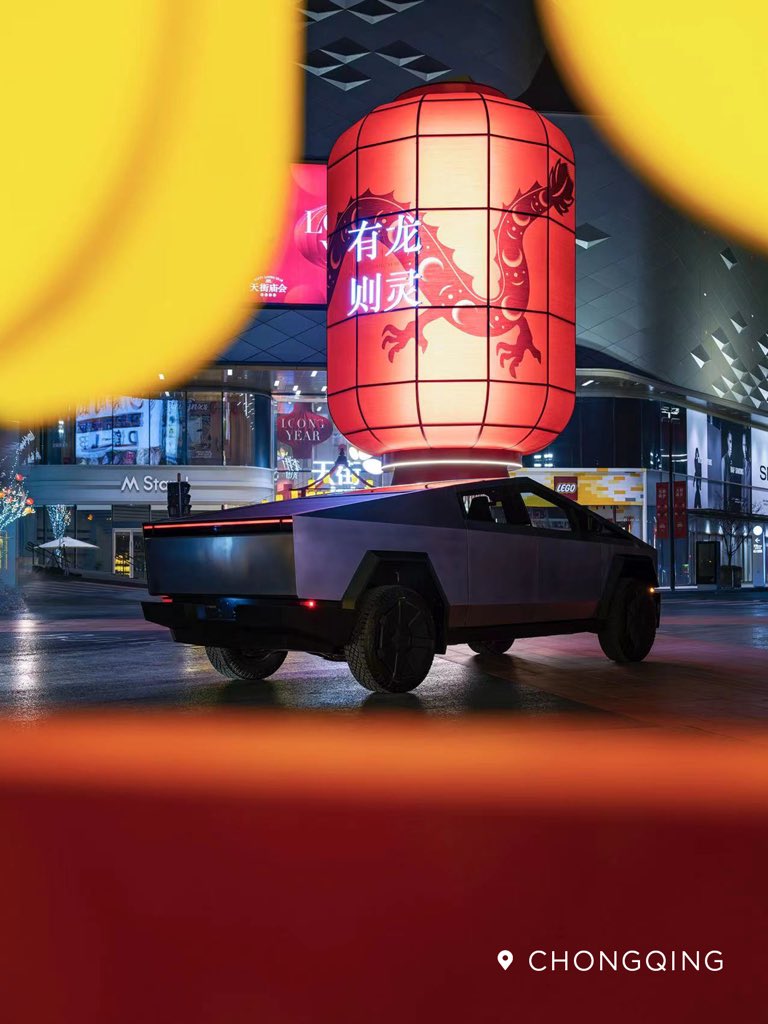Tesla has officially begun its Cybertruck tour around China, after it was revealed just weeks ago that the electric vehicle (EV) would be put on display in the country.
Recent reports noted that the Cybertruck tour would simultaneously commence in Shanghai, Beijing, Shenzhen, Chengdu, Nanjing, Hangzhou, Xi’an, and Chongqing. In a post on X on Saturday night, Tesla shared four photos of the Cybertruck in some of these cities, officially announcing that the vehicle’s debut tour in China has begun.
The photos include shots of the Cybertruck in Chongqing, Xi’an, Shanghai, and Shenzhen, as you can see below:
Credit: Tesla Asia | X Credit: Tesla Asia | X Credit: Tesla Asia | X Credit: Tesla Asia | X



A poster shared by Tesla China a little over a week ago noted that interested parties will have until March 31 to submit cities where they would like to see the Cybertruck, though it isn’t clear how long the EVs are expected to remain on display in the country.
One viewer, X user Ray4Tesla, managed to capture and share video footage of the Cybertruck tour launch, as taken on Saturday at the Shenzhen China Resources Center Vientiane Plaza. The video shows a long line to see the Cybertruck up close, surrounded by a larger crowd of pedestrians passing by and walking up to see the EV.
Cybertruck China Tour was really eventful on day 1 in all 8 locations across China. People are genuinely interested in this unique vehicle. There’s a market there for this type of recreational/adventure vehicle. Hopefully Tesla will be able to tweak it to comply with pedestrian… pic.twitter.com/xd7gCAE0gn
— Ray (@ray4tesla) January 28, 2024
The Tesla Cybertruck displays arrived in China last weekend, just over a week after an exchange on X with Elon Musk suggested that the EVs could be shipped to the country for display purposes. Despite this, Musk also said in the original post that it “would be very difficult” to make the Cybertruck road legal in China, though he did not disclose why.
Although Tesla originally opened orders for the Cybertruck in China and much of Europe, the U.S. automaker stopped accepting orders in these markets in 2022. At the time, Musk cited demand exceeding production as the reason why, though his recent statements highlight long-held conversations about the large electric pickup’s legality outside of North America.
It isn’t entirely clear why the Cybertruck would be so hard to make road legal in China, though many point to strict pedestrian safety standards and the overall size of the vehicles as some potential reasons. Tesla Vice President of Vehicle Engineering Lars Moravy hinted at some of these regulations in Europe in statements to Top Gear last month, noting that these countries have specific requirements on the roundedness of protruding parts:
“One, the truck market in the US is huge and two, European regulations call for a 3.2mm external radius on external projections,” Moravy explained. “Unfortunately, it’s impossible to make a 3.2mm radius on a 1.4mm sheet of stainless steel.”
What are your thoughts? Let me know at zach@teslarati.com, find me on X at @zacharyvisconti, or send your tips to us at tips@teslarati.com.

News
Tesla starts showing how FSD will change lives in Europe
Local officials tested the system on narrow country roads and were impressed by FSD’s smooth, human-like driving, with some calling the service a game-changer for everyday life in areas that are far from urban centers.

Tesla has launched Europe’s first public shuttle service using Full Self-Driving (Supervised) in the rural Eifelkreis Bitburg-Prüm region of Germany, demonstrating how the technology can restore independence and mobility for people who struggle with limited transport options.
Local officials tested the system on narrow country roads and were impressed by FSD’s smooth, human-like driving, with some calling the service a game-changer for everyday life in areas that are far from urban centers.
Officials see real impact on rural residents
Arzfeld Mayor Johannes Kuhl and District Administrator Andreas Kruppert personally tested the Tesla shuttle service. This allowed them to see just how well FSD navigated winding lanes and rural roads confidently. Kruppert said, “Autonomous driving sounds like science fiction to many, but we simply see here that it works totally well in rural regions too.” Kuhl, for his part, also noted that FSD “feels like a very experienced driver.”
The pilot complements the area’s “Citizen Bus” program, which provides on-demand rides for elderly residents who can no longer drive themselves. Tesla Europe shared a video of a demonstration of the service, highlighting how FSD gives people their freedom back, even in places where public transport is not as prevalent.
What the Ministry for Economic Affairs and Transport says
Rhineland-Palatinate’s Minister Daniela Schmitt supported the project, praising the collaboration that made this “first of its kind in Europe” possible. As per the ministry, the rural rollout for the service shows FSD’s potential beyond major cities, and it delivers tangible benefits like grocery runs, doctor visits, and social connections for isolated residents.
“Reliable and flexible mobility is especially vital in rural areas. With the launch of a shuttle service using self-driving vehicles (FSD supervised) by Tesla in the Eifelkreis Bitburg-Prüm, an innovative pilot project is now getting underway that complements local community bus services. It is the first project of its kind in Europe.
“The result is a real gain for rural mobility: greater accessibility, more flexibility and tangible benefits for everyday life. A strong signal for innovation, cooperation and future-oriented mobility beyond urban centers,” the ministry wrote in a LinkedIn post.
News
Tesla China quietly posts Robotaxi-related job listing
Tesla China is currently seeking a Low Voltage Electrical Engineer to work on circuit board design for the company’s autonomous vehicles.

Tesla has posted a new job listing in Shanghai explicitly tied to its Robotaxi program, fueling speculation that the company is preparing to launch its dedicated autonomous ride-hailing service in China.
As noted in the listing, Tesla China is currently seeking a Low Voltage Electrical Engineer to work on circuit board design for the company’s autonomous vehicles.
Robotaxi-specific role
The listing, which was shared on social media platform X by industry watcher @tslaming, suggested that Tesla China is looking to fill the role urgently. The job listing itself specifically mentions that the person hired for the role will be working on the Low Voltage Hardware team, which would design the circuit boards that would serve as the nervous system of the Robotaxi.
Key tasks for the role, as indicated in the job listing, include collaboration with PCB layout, firmware, mechanical, program management, and validation teams, among other responsibilities. The role is based in Shanghai.
China Robotaxi launch
China represents a massive potential market for robotaxis, with its dense urban centers and supportive policies in select cities. Tesla has limited permission to roll out FSD in the country, though despite this, its vehicles have been hailed as among the best in the market when it comes to autonomous features. So far, at least, it appears that China supports Tesla’s FSD and Robotaxi rollout.
This was hinted at in November, when Tesla brought the Cybercab to the 8th China International Import Expo (CIIE) in Shanghai, marking the first time that the autonomous two-seater was brought to the Asia-Pacific region. The vehicle, despite not having a release date in China, received a significant amount of interest among the event’s attendees.
Elon Musk
Elon Musk and Tesla AI Director share insights after empty driver seat Robotaxi rides
The executives’ unoccupied tests hint at the rapid progress of Tesla’s unsupervised Robotaxi efforts.

Tesla CEO Elon Musk and AI Director Ashok Elluswamy celebrated Christmas Eve by sharing personal experiences with Robotaxi vehicles that had no safety monitor or occupant in the driver’s seat. Musk described the system’s “perfect driving” around Austin, while Elluswamy posted video from the back seat, calling it “an amazing experience.”
The executives’ unoccupied tests hint at the rapid progress of Tesla’s unsupervised Robotaxi efforts.
Elon and Ashok’s firsthand Robotaxi insights
Prior to Musk and the Tesla AI Director’s posts, sightings of unmanned Teslas navigating public roads were widely shared on social media. One such vehicle was spotted in Austin, Texas, which Elon Musk acknowleged by stating that “Testing is underway with no occupants in the car.”
Based on his Christmas Eve post, Musk seemed to have tested an unmanned Tesla himself. “A Tesla with no safety monitor in the car and me sitting in the passenger seat took me all around Austin on Sunday with perfect driving,” Musk wrote in his post.
Elluswamy responded with a 2-minute video showing himself in the rear of an unmanned Tesla. The video featured the vehicle’s empty front seats, as well as its smooth handling through real-world traffic. He captioned his video with the words, “It’s an amazing experience!”
Towards Unsupervised operations
During an xAI Hackathon earlier this month, Elon Musk mentioned that Tesla owed be removing Safety Monitors from its Robotaxis in Austin in just three weeks. “Unsupervised is pretty much solved at this point. So there will be Tesla Robotaxis operating in Austin with no one in them. Not even anyone in the passenger seat in about three weeks,” he said. Musk echoed similar estimates at the 2025 Annual Shareholder Meeting and the Q3 2025 earnings call.
Considering the insights that were posted Musk and Elluswamy, it does appear that Tesla is working hard towards operating its Robotaxis with no safety monitors. This is quite impressive considering that the service was launched just earlier this year.










